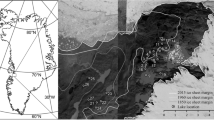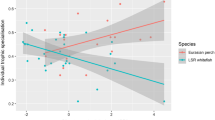Abstract
Trophic-niche differentiation is often cited as a main factor in structuring zooplankton assemblages, although field evidence for this is rarely presented. The study was based on a survey of 29 Pyrenean lakes with altitudes ranging between 1,875 and 2,990 m carried out during July and August 2000. Because of the oligotrophic nature of these lakes, we aimed to confirm that food partitioning is a major factor in shaping zooplankton assemblages. We analysed the amino acid composition of six cladocera and seven copepod species. A discriminant analysis showed that each species could be distinguished according to its amino acid composition. A negative relationship between amino acid differentiation and co-occurrence among the cladocera and cyclopoid copepod was observed. In contrast, calanoids did not show any relationship and were characterised by a high amino acid differentiation between species. As the differences in the amino acid composition among zooplankton species indicate distinct food sources, the relationship found indicates that trophic-niche differentiation plays a key role in determining the assemblage of these zooplankton communities. Therefore exploitative competition, either at present or in the past by driving co-evolutionary histories, has been a significant factor in structuring the cladocera and cyclopoid communities in these oligotrophic lakes.





Similar content being viewed by others
References
Allan JD (1973) Competition and the relative abundances of two cladocerans. Ecology 54:484–498
Arnott SE, Vanni MJ (1993) Zooplankton assemblages in fishless bog lakes: Influence of biotic and abiotic factors. Ecology 74:2361–2380
Catalan J, Ventura M, Brancelj A, Granados I, Thies H, Nickus U, Korhola A, Lotter AF, Barbieri A, Stuchlík E, Lien L, Bitušík P, Buchaca T, Camarero L, Goudsmit GH, Kopáček J, Lemcke G, Livingstone DM, Müller B, Rautio M, Šiško M, Sorvari S, Šporka F, Strunecký O, Toro M (2002) Seasonal ecosystem variability in remote mountain lakes. Implications for detecting climatic signals in sediment records. J Paleolimnol 28:25–46
Cowie GL, Hedges JI (1996) Digestion and alteration of the biochemical constituents of a diatom ( Thalassiosira weissflogii), ingested by an herbivorous zooplankton ( Calanus pacificus). Limnol Oceanogr 41:581–594
Davison AC, Hinkley DV (1997) Bootstrap methods and their applications. Cambridge University Press, New York
DeMott RW (1986) The role of taste in food selection by freshwater zooplankton. Oecologia 69:334–340
Dodson SI (1974) Zooplankton competition and predation: an experimental test of the size-efficiency hypothesis. Ecology 55:605–613
Duncan A (1989) Food limitation and body size in the life cycles of planktonic rotifers and cladocerans. Hydrobiologia 186/187:11–28
Giller PS (1984) Community structure and the niche. Chapman & Hall, London
Gliwicz ZM (1985) Predation or food limitation: an ultimate reason for extinction of planktonic cladocera species. Arch Hydrobiol Beih Ergebn Limnol 39:419–430
Gliwicz ZM (1990) Food thresholds and body size in cladocerans. Nature 343:638–640
Gliwicz ZM, Rowan MG (1984) Survival of Cyclops abyssorum tartricus (Copepoda, Crustacea) in alpine lakes stocked with planktivorous fish. Limnol Oceanogr 29:1290–1299
Guisande C, Maneiro I, Riveiro I (1999) Homeostasis in the essential amino acid composition of the marine copepod Euterpina acutifrons. Limnol Oceanogr 44:691–696
Guisande C, Riveiro I, Maneiro I (2000) Comparison between the amino acid composition of females, eggs and food to determine the relative importance of food quantity and food quality on copepod reproduction. Mar Ecol Prog Ser 202:135–142
Guisande C, Maneiro I, Riveiro I, Barreiro A, Pazos Y (2002) Estimation of copepod trophic-niche in the field using amino acids and marker pigments. Mar Ecol Prog Ser 239:147–156
Hansen AM, Hairston NG Jr (1998) Food limitation in a wild cyclopoid copepod population: direct and indirect life history responses. Oecologia 115:320–330
Irigoien X, Head RN, Harris RP, Cummings D, Harbour D, Meyer-Harms B (2000) Feeding selectivity and egg production of Calanus helgolandicus in the English Channel. Limnol Oceanogr 45:44–54
Kreutzer C, Lampert W (1999) Exploitative competition in differently sized Daphnia species: a mechanistic explanation. Ecology 80:2348–2357
Lampert W, Muck P (1985) Multiple aspects of food limitation in zooplankton communities: the Daphnia - Eudiaptomus example. Arch Hydrobiol Beih Ergebn Limnol 21:311–322
Leibold MA (1995) The niche concept revisited: mechanistic models and community context. Ecology 76:1371–1382
Makino W, Ban S (2000) Response of life history traits to food condition in a cyclopoid copepod from an oligothrophic environment. Limnol Oceanogr 45:396–407
Meyer-Harms B, Bodungen B von (1997) Taxon-specific ingestion rates of natural phytoplankton by calanoid copepods in an estuarine environment (Pomeranian Bight, Baltic Sea) determined by cell counts and HPLC analyses of marker pigments. Mar Ecol Prog Ser 153:181–190
Müller-Navarra D, Lampert W (1996) Seasonal patterns of food limitation in Daphnia galeata: separating food quantity and food quality effects. J Plankton Res 18:1137–1157
Navarro JC, McEvoy IA, Amat F, Sargent JR (1995) Effects of diet on fatty acid composition of body zones in larvae of the sea bass Dicentrarchus labrax: a chemometric study. Mar Biol 124:177–183
Ślusarczyk M (2001) Food threshold for diapause in Daphnia under the threat of fish predation. Ecology 82:1089–1096
Soto D, Hurbert SH (1991) Long-term experiments on calanoid-cyclopoid interactions. Ecol Monogr 61:245–265
Southwood TRE (1978) Ecological methods. Chapman & Hall, London
Stemberger PL, Gilbert JJ (1985) Body size, food concentration and population growth in planktonic rotifers. Ecology 66:1151–1159
Stemberger PL, Gilbert JJ (1987) Rotifer threshold food concentrations and the size efficiency hypothesis. Ecology 68:181–187
Tessier AJ, Goulden CE (1982) Estimating food limitation in cladocera populations. Limnol Oceanogr 27:707–717
Threlkeld ST (1976) Starvation and the size structure of zooplankton communities. Freshwater Biol 6:489–496
Tilman D (1982) Resource competition and community structure. Princeton University Press, Princeton, N.J.
Vanni MJ (1986) Competition in zooplankton communities: suppression of small species by Daphnia pulex. Limnol Oceanogr 31:1039–1056
Ventura M, Camarero L, Buchaca T, Bartumeus F, Livingstone DM, Catalan J (2002) The main features of seasonal variability in the external forcing and dynamics of a deep mountain lake (Redó, Pyrenees). J Limnol 59:97–108
Wandelen CH van, Cohen SA (1997) Using quaternary high-performance liquid chromatography eluent systems for separating 6-aminoquinolyl- N -hydroxysuccinimidyl carbamate-derivatized amino acid mixtures. J Chromatogr 763:11–22
Weiher E, Keddy P (1999) Ecology assembly rules. Perspective, advances, retreats. Cambridge University Press, Cambridge
Acknowledgements
We thank all those who helped in fieldwork, particularly to D. Alonso for late night extra fieldworks and T. Buchaca for chlorophyll analyses. This research was supported by the European Commission (contract EVK1-CT-1999–00032, EMERGE project).
Author information
Authors and Affiliations
Corresponding author
Rights and permissions
About this article
Cite this article
Guisande, C., Bartumeus, F., Ventura, M. et al. Role of food partitioning in structuring the zooplankton community in mountain lakes. Oecologia 136, 627–634 (2003). https://doi.org/10.1007/s00442-003-1306-4
Received:
Accepted:
Published:
Issue Date:
DOI: https://doi.org/10.1007/s00442-003-1306-4




